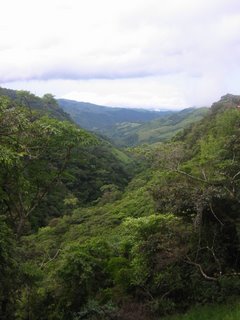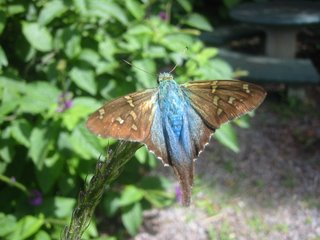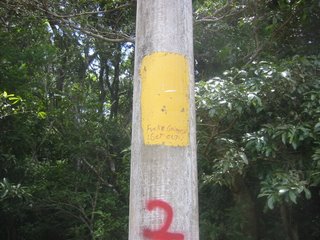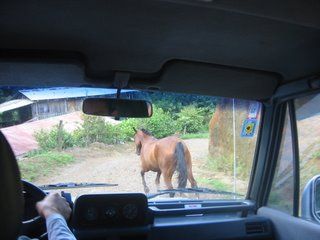Sunday, July 30, 2006
Friday, July 28, 2006
Salsa
None of us really wanted to go to a 2 hour dance class after Faculty meeting, but then none of us wanted to walk home in the rain. We went to the class. It was in a brightly coloured room packed with about 35 women of all ages and sizes and exactly 9 men (we knew because the instructor had to count them). The instructor himself was very pretty and when he stood on the stage to show us the hip movements and tucked his shirt into his trousers there was an awful lot of nervous giggling from the women. It was a great class with the very beginnings of salsa, meringue, bolero, cha-cha and the local and more folksy cumbia. We sweated like we do everyday, but it was more fun to be sweating to music. Gradually over the course of the class people dropped out and sat down, there were about 15 of us left by the end. We're going back for sure next week.
One of the interns is a professional dancer and she's offereing 'stretch, strengthen and relax' classes twice a week. We began yesterday. Everyone had forgotten the strengthen part and I for one was totally shocked when the opress ups and lunges came. We'll be so buff by the end of this, for sure.
Posted by
Ancel
at
3:51 pm
![]()
Tuesday, July 25, 2006
milky milky
I buy my milk at the supermarket. It's in a fridge round the back, a fridge with a great big churn in it. Above the fridge is a box of plastic bags. There's a tap at the foot of the churn and you fill the bag with milk. Double bagging is best, otherwise you stand the chance of losing milk in a trail through the vegetable section. The milk is delicious, but I'm hoping to get my milk from the cow across the road soon.
Posted by
Ancel
at
5:41 pm
![]()
Sunday, July 23, 2006
gringos a go go
This is the only evidence I’ve seen of anti-gringo feeling, it’s on a lamp-post tucked away down a very quiet road. It’s fitting that the word ends in the sign for colones.
This area was bought in 1900 or thereabouts by a Tico gold company, a mine existed here until the late 30s when it became too expensive to run. By that time a very small community of farmers had grown around the miners, when the mine shut the miners became squatter farmers. In 1950 a group of Quakers from Alabama bought the land from the mining company and arrived along the oxen trail which led up from the lowlands. They were dairy farmers but milk doesn’t keep and so they began to experiment with different cheeses.
In the 70s conservation began and more gringos came to study the land. The influx of whites grew and today Monteverde receives more than 200,000 tourists a year. The resident community numbers around 5,000. The tourists have an enormous impact. Most stores take dollars and the bank provides accounts in both dollars and colones. I have two accounts which makes sense as the value of the colone drops slightly each day against the dollar, today for example there are 513 to the $. Monteverde is the most expensive part of Costa Rica, land prices are rising all the time. There is a house for sale in Monteverde, nice place going for $2.4 million. I get paid the going rate for Tico teachers - $5,000 a year. You can tell who’s not going to be able to afford to own homes in Monteverde. Last night I paid $3 for a pepsi, I was fairly shocked, but then again I was in a café which served braised chicken livers on a bed of wilted spinach: not exactly typical Tico fare.
Hotels abound here, restaurants, tourist offices, really there are too many competing against each other. This has been a slow year, numbers are down and the businesses are suffering. Almost all the business here is locally owned so the gringos have a very direct effect on the local economy.
An environmental effect too. The roads create a huge amount of water run-off creating erosion and slides further down the mountain. Water usage is on the increase so much so that some areas don’t have water during the dry season – incredible for an area that receives over 100 inches of rain a year. Buildings go up anywhere, anyhow without any planning or permits. Each little section has its own antiquated septic system. Water from laundry and shower goes straight into street drains. It’s a huge challenge. We have gone from an agricultural society to one based on eco-tourism and yet serving the tourists is destroying the environment. The balance has not been struck. I feel like an abuser myself trying to leave as little impact on the land as I can, but knowing that my presence here has the potential to tip the scales.
If the Quakers hadn’t come this might have remained a very sleepy agricultural area. Sooner or maybe later the forest might have been stripped away as the demand for hardwood lumber, particularly mahogany, rose. There might have been conservation attempts. But instead the Quakers immediately set aside protected land and it was the visiting scientists who began to buy land and raise awareness internationally of how important this area is. Without the gringos there would be no Monteverde.
This is a multi-lingual cosmopolitan area. While I understand the sentiment I’m growing more aligned to a global approach to land and nationality. Maybe there are gradations of gringo, I hope so.
Posted by
Ancel
at
3:27 pm
![]()
rain and sangria
According to the tourist guides this is the rainy season. But people here say, “oh wait ‘til the rains come”. They usually say this when I’m standing drenched after a torrential downpour, feet caked in mud and steaming gently under my plastic see-through poncho. Thus far I’ve smiled weakly and kept my mouth shut. But Friday was different. The rains began about 2:30 just as we were walking home from school. It had been a warm day after a night of rain. It started lightly with pulses of heavier rain. Barbara and I had gone for ice-cream – volcanoes actually, 2 scoops of local ice-cream topped with condensed milk, ground coffee and whipped cream.
We put off leaving as long as possible, but there was no sign of slacking. Ponchos are cleverly designed to direct all the water that falls on you to your lower third. Within 50 paces we were squelching mud through our sandals and weighed down by the 20lbs of water which was slowly creeping up our skirts. We got to Barbara’s house and I continued knowing I had a good 40 more minutes of walking. However as luck would have it I met Kris and we decided to have a coffee and wait for Katy. Our evening plans were to see some flamenco.
The bar we were meeting Katy at was the flamenco bar. We ordered coffee, hung up our raingear and wrung out our skirts. We sat by the open doors and watched the rain bounce off the tourists. The dampness had crept up to my thighs but the coffee came with cookies. Katy came and we chatted. The time passed, the rain didn’t. I wanted to go home and put on dry clothes, Kris left, Jesse arrived. Chico the owner brought us some sangria to try. He was experimenting and we tried a couple of samples. The dampness didn’t seem so bad anymore. It got dark, Barbara and Michael arrived and the flamenco didn’t show up. We drank more sangria and Chico put on early MTV videos. The interns arrived and we began ordering pitchers of sangria. All 7 new teachers arrived in Costa Rica together, we began the fairly serious business of bonding from the first night. A collection of people thrown together in a strange country soon develop a trust and fondness for each other. We shared stories, the typical ones: first kiss, first drinking experience, first taking of the parents’ car. It was great. I was really the only one who knew the 80’s music clips, but that was okay. The rain got so hard the bar was shaking. It finally stopped just before we left. My clothes had dried, though my sandals still squelched.
They chose to spread a fresh layer of dirt on the road Saturday morning. It was warm and sunny. Saturday afternoon the rains began and we slid home on the layer of mud which coated all the old mud. Kris found that the horse shit which litters the road gave better traction but my flip flopped feet didn’t seem to fancy it so I continued to slide all the way down the hill. On Saturday night, after more rain we headed back out to see a vibraphone player. Walking up the hill was a long and slow process as every step forward was balanced by a slide backwards. Though I have to say we were progressing so slowly I didn’t break into my usual drenching sweat. We were slow but not so slow as the taxis and quads which were wheel spinning and slipping in the mud. The night became clear and windy. And even though the taxi drivers refused to give us a ride home – knowing that the road was just slippery mush, we made it home quicker as the 3 hours of windy weather had dried the mud somewhat. Rainy season will start soon. I’m scared.
Posted by
Ancel
at
3:23 pm
![]()
school
School began in a flood of blue t-shirts and chatter. I have a class of 12, from age 9 to 11: fire rats and fire oxen. There are 4 girls and 8 boys – this ratio is fairly common throughout the school, being a private school it is culturally appropriate to place the education of the son higher than that of the daughter. Over sixty percent of the students receive scholarships: some are sponsored by North American families, others are helped by the school’s fundraising activities. Over ninety percent are local, I have two native English speakers in my class though both have spent almost all of their lives in Central America.
The children are charming, their English is incredibly poetic – beautiful is a common word, or rather vutifol. We will be working a lot with pronunciation. Jose Andreas each morning greets me with, “it is a pleasure Ancel”, while holding my hand and looking along his nose, eyes slightly closed like the count from some early talking movie; Catalina, my one faculty child never stops talking; Eduardo who’s father was killed hunting iguanas grins at me shyly and Daniel my ‘bad’ boy pretends to be aloof. They are great kids, I think I’m really lucky. Having no Spanish may or may not be a blessing. I have very little idea what they are saying amongst themselves, but it means I can’t cheat and they have to hear English. I did however squeak out a little Spanish on Thursday and immediately Michael said with perfect seriousness, “English please” – it must have been a phrase they heard a lot last year. Funnily enough their last teacher had some Waldorf experience – there are definite inklings of Steiner ed., in their mannerisms. My two native English speakers have Waldorf connections also.
I work closely with the other 4th and 3rd grade teachers: this has proven to be the bigger challenge (surprise surprise) – not because of who they are, I have fairly major crushes on both, but because we have completely different perspectives on pedagogy. I am very slowly managing to stop looking horrified and they are very slowly managing to accept my elaborate board illustrations outlining how everything is connected. They talk in state school jargon; personal narrative, writerly lives, baseline literature, and I don’t talk. They are both great teachers. Very interesting.
Posted by
Ancel
at
3:21 pm
![]()
Saturday, July 15, 2006
The Bridge

We are a good 20 minutes walk below Santa Elena, sometimes it's nice to take a taxi. Getting a taxi here is quite a process and relies on the machismo of Tico men. There's a bridge which must be crossed and on the phone you can hear the office asking the drivers who will do it. Inevitably a voice will ring out after pauses and low muttering "I will do it, I will cross the bridge". Fifteen minutes later we hear the taxi struggling up the hill and the driver gallantly opens the door for us. Crossing the bridge can be done several ways - some creep across, some speed, others pause - one driver edges backwards. Their heads are always held slightly higher once across as we make the climb to town.
I'm trying to make friends with the taxi drivers. No one has a street address here, my address for instance is often 'across the road from casa de Maestra Gina'. It pays to be known. So in terribly broken Spanish I introduce myself, say what I do and where I work and ask as much "Como se dice . . ." as I can get in. And it has other benefits too: my fare is usually half the price of what the gringos pay.
Becoming a local is important. A cafe which puts on a great Caribbean evening every Thursday with thumping reggae, mango on the menu and Cuba Libre - a heavy on the rum cocktail, has two prices: local and tourist. It's the difference between paying $4 for dinner and $1.60. So we introduce ourselves to the waitress (who comes from Santa Rosa) and the cooks and the DJ. On the way home the taxi pauses before crossing the bridge. I offer to get out and walk the rest, it's really fine, you don't have to cross. But the machismo kicks in - no, no, of course I'll cross.
Posted by
Ancel
at
7:20 pm
![]()
Santa Elena
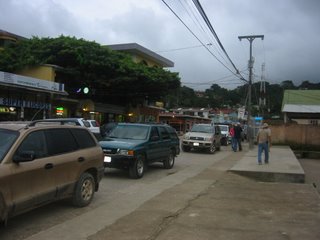
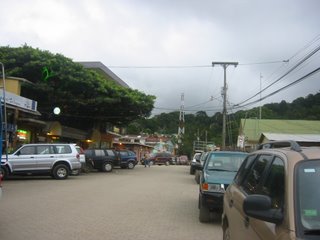

This is Santa Elena, the 'town', maybe 3 paved crossing streets on a hill where life all happens. Santa Elena is mostly Tico, there are a few hotels on the fringes and tourist shops, but here are the banks, the bus station, the church, the vets and the supermarcado. The roads are filled with dogs, buses, trucks, people, taxis and horses who all battle for position and supremacy. Sideroads drop down into ravines which lead back up into residential areas. Men and boys perch on the sidewalk talking and watching, tourists struggle with backpacks and vertigo and teenagers slouch by on their cell phones.
Posted by
Ancel
at
7:05 pm
![]()
Wednesday, July 12, 2006
This morning I took a taxi to school, the taxi driver took yet another route, but this one I'm sure I'll remember. We climbed up an incredible hill - easily as steep as anything San Francisco has to offer, yet here there is no tarmac, but loose rocks and gravel. In 4 wheel drive, grabbing onto potholes we revved our way to the top. The view from the school is incredible - my pictures won't do it justice. Miles of green and rounded hills sinking away to the Gulf: water so reflective of the sky it's sometimes hard to see, except for the wooded islands which tower out of it and the penninsula beyond.
I got bitten by an army ant yesterday. I saw the line of ants and stepped across, but one kamikaze little bugger managed to launch himself onto my foot. It hurt intensely for 5 minutes - like stinging nettle pain focused on one place, but that one tiny place managing to pulsate, throb and burn like it was all through my leg. I must take care not to wear flip-flops in the forest.
There are so many dogs here, all thankfully seem friendly and approach with stupid grins and wagging tails. Most are strange mixes - like labs and german shepherds with corgi sized legs and St Bernard sized heads. They seem to live independently of their owners, nosing around in the streams or futzing along the roads. They wander through the supermarket or sit in cafe doors.
Tonight I walked home and only got lost once. My way was lit by lightning bolts which were too far away for me to hear and by fire-flies which were close enough for me to hear. They zig zag blinking through the air like tiny strobe lights. Wonderful.
Posted by
Ancel
at
7:49 pm
![]()
Life in Monteverde
Imagine a green mountain so lush it shines brilliantly in the sun beckoning and yet defying visitors. A dusty road snakes around it passing brahman cows who stand knee deep in grass behind fences which have sprouted leaves. Golden hens strutt beside sleeping dogs, from everywhere one can hear the whisper of growth.
Posted by
Ancel
at
7:29 pm
![]()
